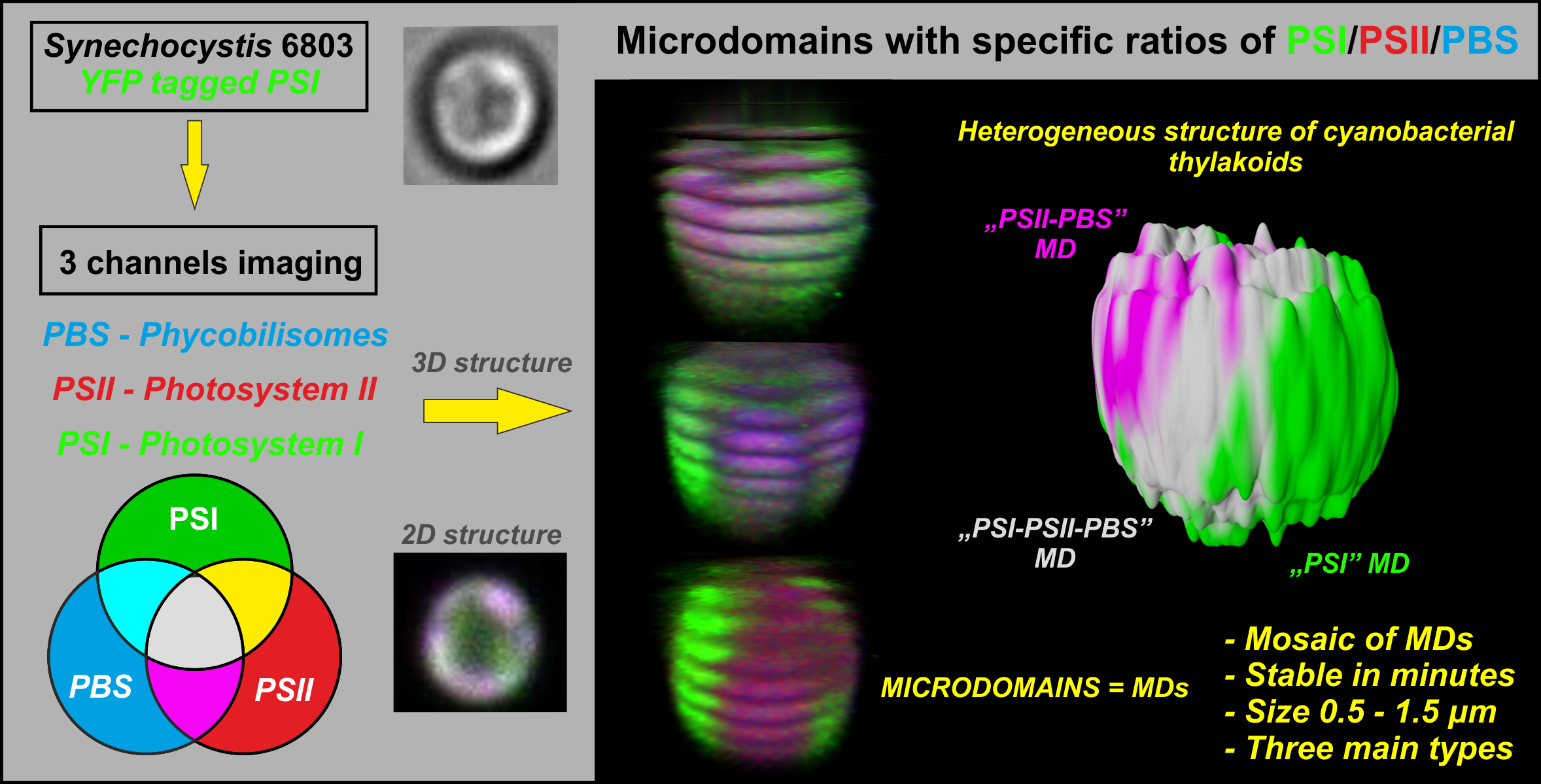Laboratory of Photosynthesis
Radek Kana`s group
Membranes heterogeneity in photosynthesis
We study organization of thylakoid membrane proteins (MICRODOMAINS) and mechanisms of photoprotection (NPQ).
Heterogenerous mosaic of proteins in thylakoids of cyanobacteria - MICRODOMAINS
Biological membranes were originally described as uniform fluid-mosaic of lipids and proteins. Later, heterogeneous membrane areas have been found in many membrane systems including cyanobacterial thylakoids. There, the heterogeneous areas are formed by pigment-protein complexes (photosystems, light-harvesting antennas) responsible for bioenergetics of light-harvesting in photosynthesis. These complexes are naturally self-organized into homo-/hetero- oligomers (nanodomains) that create sub-micrometer-sized in vivo microdomains (e.g. granal/stromal thylakoids in higher plants or cyanobacterial microdomains). In the project, we study imporrtance of thylakoid membranes heterogeneity, especially for light-harvesting in cyanobacteria. We use up-to-date methods of superresolution microscopy (Zeiss LSM 880 with Airyscan detector) and time/spatial cross-correlation microcopy (FRAP, FCS etc. ) address microdomains heterogeneity caused by nanodomains. Thanks to the molecular biology methods (specific mutants) we want to establish a link between membrane heterogeneity and the ligh-harvesting tfunction of photosystems and phycobilisoms in vivo.
|
We have identified and descr |
| [1] Strašková A et al. (2019) Pigment-protein complexes are organized into stable microdomains in cyanobacterial thylakoids Biochimica et Biophysica Acta (BBA) - Bioenergetics 1860 |
| [2] Konert G, Steinbach G, Canonico M, Kaňa R (2019) Protein arrangement factor: a new photosynthetic parameter characterizing the organization of thylakoid membrane proteins Physiol Plantarum 166:264-277 |
| [3] Canonico M, Konert G, Kaňa R (2020) Plasticity of Cyanobacterial Thylakoid Microdomains Under Variable Light Conditions Frontiers in Plant Science 11 |
| [4] Steinbach G, Schubert F, Kana R (2015) Cryo-imaging of photosystems and phycobilisomes in Anabaena sp PCC 7120 cells J Photochem Photobiol B-Biol 152:395-399 |
Photoprotection - mechanism of non-photochemical quenching - NPQ
Photosynthetic organisms are often exposed to highly fluctuating light-conditions with short periods of excessive irradiation. Therefore, they had to developed a several photoprotective mechanisms that can cope with with conditions when excessive light can produced .ROS and destroy photosynthetic apparatus. We have studied several model organisms including green plants (spinach, arabidopsis), algae (chromerids, cryptophytes alga), cyanobacteria to resolve molecular mechanism mechanisms of photoprotection. It includes non-photochemical quenching, photoinhibition, phycobilisome decoupling or state transitions. It is still an open question how much are those processes are connected with a short or a long-term TM re-organization on nano- and micro-scale levels.
Mechanism of NPQ in cryptophytes |
Mechanism of NPQ in chromerids |
 ibed heterogeneous organisation of cyanobacterial thylakoid membrane proteins into MICRODOMAINS [1]. We study importance of the mosaic-like organization of Photosystems (PSI and PSII) and Phycobilisomes for overall function of photosynthesis especially for light-harvesting. The microdomains organization of thylakoids is based on PSI/PSII/PBS co-localization (visible as Red-Green-Blue color coding pictures), its is stable in minutes/hours, and it can ponly slowly adapt to different growing conditions [3]. Microdomains seems to be typical for cyanobacterial strains [4] and and they resembles grana/stromal heterogenity in PSI/PSII distribution typical for higher plants thylakoids.
ibed heterogeneous organisation of cyanobacterial thylakoid membrane proteins into MICRODOMAINS [1]. We study importance of the mosaic-like organization of Photosystems (PSI and PSII) and Phycobilisomes for overall function of photosynthesis especially for light-harvesting. The microdomains organization of thylakoids is based on PSI/PSII/PBS co-localization (visible as Red-Green-Blue color coding pictures), its is stable in minutes/hours, and it can ponly slowly adapt to different growing conditions [3]. Microdomains seems to be typical for cyanobacterial strains [4] and and they resembles grana/stromal heterogenity in PSI/PSII distribution typical for higher plants thylakoids.